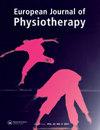Development and pilot-testing of a behavioural intervention to enhance physical activity in patients admitted to the cardiology ward: a proof-of-concept study
IF 1.1
Q3 REHABILITATION
引用次数: 1
Abstract
Abstract Purpose To examine the feasibility and potential effectiveness of a behavioural intervention to increase physical activity in patients admitted to the cardiology ward. Methods In this proof-of concept study, we developed an intervention supporting self-efficacy and diminishing inertia by means of autonomy support and action planning. Data collection took place from April till July 2018, including a three-week intervention period. Feasibility was assessed with a semi-structured interview among patients (n = 34), a survey among nurses (n = 20), and a focus group among physical therapists (n = 4). Potential effectiveness was assessed as change in action planning, autonomy support and self-efficacy (determined using psychological questionnaires) in 30 patients, and change in physical activity (determined using behavioural mapping) before (n = 90) and after (n = 83) implementation. Results Feasibility of the behavioural intervention was deemed adequate by patients, nurses and physical therapists. Potential effectiveness was demonstrated by an increase in action planning (mean difference: 1.76; 95%-CI: 0.92–2.60), autonomy support (0.84; 0.35–1.34) and self-efficacy (0.57; 0.11–1.03). Patients in the after-group spent less time lying down (-5.96; −8.86 to −2.86) and more time standing/walking (3.34; 1.82–4.87). Conclusion The developed behavioural intervention appears to be feasible in daily clinical practice and may enhance relevant psychological determinants and physical activity in patients admitted to the cardiology ward.开发和试点测试的行为干预,以加强身体活动的病人住进心脏病病房:概念验证研究
目的探讨行为干预增加心内科住院患者身体活动的可行性和潜在有效性。方法在本概念验证研究中,我们通过自主支持和行动计划开发了一种支持自我效能和减少惯性的干预措施。数据收集于2018年4月至7月进行,包括为期三周的干预期。通过对患者(n = 34)的半结构化访谈、对护士(n = 20)的调查和对物理治疗师(n = 4)的焦点小组来评估可行性。在实施前(n = 90)和实施后(n = 83),评估了30名患者在行动计划、自主支持和自我效能(使用心理问卷确定)以及身体活动(使用行为测绘确定)方面的变化。结果患者、护士和物理治疗师均认为行为干预的可行性是充分的。通过增加行动计划来证明潜在的有效性(平均差:1.76;95%-CI: 0.92-2.60),自主支持(0.84;0.35-1.34)和自我效能感(0.57;0.11 - -1.03)。术后组患者躺卧时间较少(-5.96;−8.86至−2.86),站立/行走时间增加(3.34;1.82 - -4.87)。结论所建立的行为干预在日常临床实践中是可行的,可以增强心内科住院患者的相关心理决定因素和身体活动。
本文章由计算机程序翻译,如有差异,请以英文原文为准。
求助全文
约1分钟内获得全文
求助全文

 求助内容:
求助内容: 应助结果提醒方式:
应助结果提醒方式:


